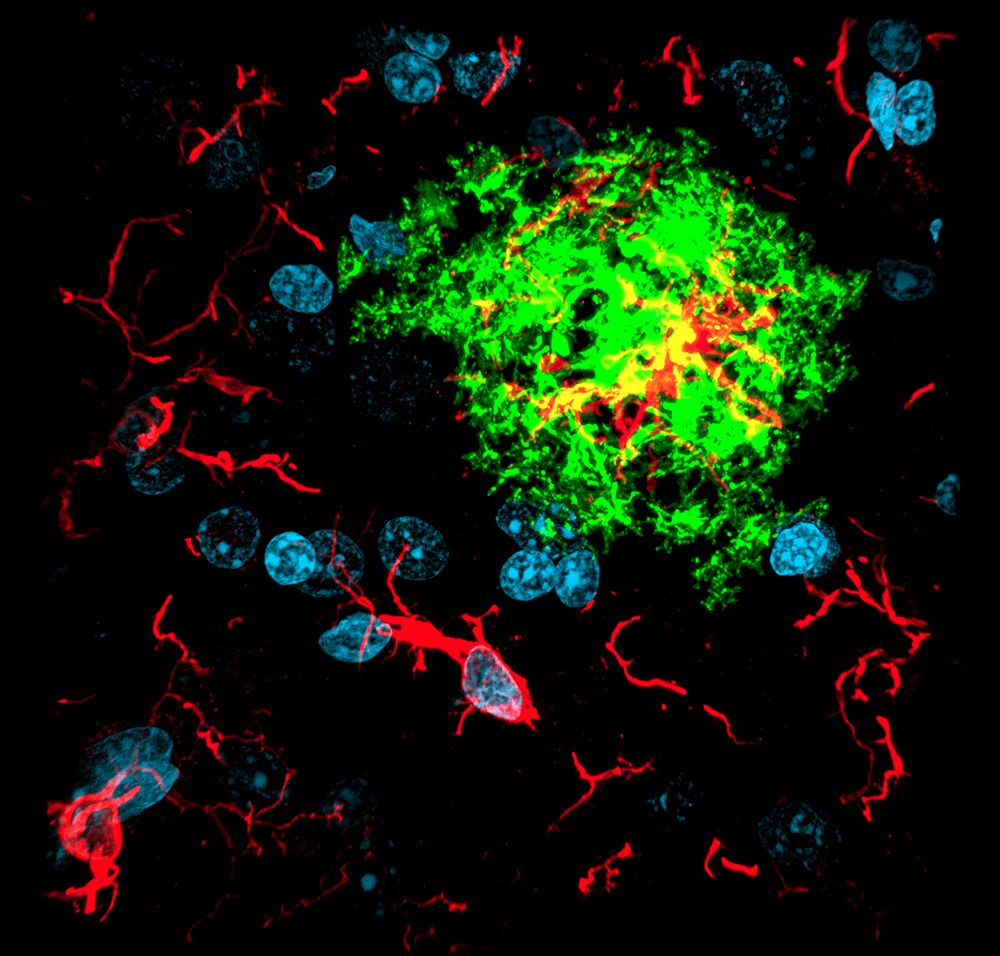
Science Snaps: Neuroscience Graduate Group Student Jaleel Jefferson Explores the Pathology of Neurodegeneration
The image shows a fluorescent gathering. Amorphous blue orbs float among scratches of red while a nebulous green haze hangs in the foreground. It’s mesmeric, the neon nature of it all, but it’s also biological.
What you’re glimpsing is a snapshot of an elderly, but healthy, Rhesus macaque’s brain. Specifically, you’re looking at a minute section of its medial temporal lobe. The blue bits are cell bodies; the red, microglial cells, which are the brain’s resident immune cells that respond to inflammation. And that green haze, that’s beta-amyloid plaque buildup.

“It is a result of natural aging,” said Neuroscience Graduate Group student Jaleel Jefferson, who snapped this neuronal moment. “It’s not the worst thing that can happen, but it’s also not great.”
While beta-amyloid plaque buildup is a natural part of aging, an overabundance of it is found in the brains of those with Alzheimer’s disease. Understanding how healthy brains sweep away theses cobweb-like plaques is pertinent to understanding how this process changes with age, goes awry and why that leads to neurodegenerative diseases.
“Part of one microglia’s appendages were extending through the amyloid plaque so we were certain that the cell was responding to the presence of the plaque, though we are still unsure what the response means,” said Jefferson, who produced the image while rotating through neuroscience labs during his first year of graduate school.
Jefferson studies the pathology of neurodegenerative diseases in the lab of Professor of Neurology John Morrison, the director of the California National Primate Research Center. Specifically, Jefferson investigates the neuropathology of a condition known as HIV Associated Neurocognitive Disorders (HAND), which encompasses “a spectrum of cognitive, motor, and/or mood problems” that affect people with HIV.
“People…who have had HIV for a long period of time are developing neurological disorders earlier in life compared to people who typically develop them much later in life in their 70s and 80s,” said Jefferson. “HIV patients are developing them in their 50s and 60s.”
Jefferson uses animal models to understand how HAND develops and how its neuropathology compares to the neuropathology of Alzheimer’s disease. His interest in neuroscience traces back to his childhood. During middle school, his grandmother was diagnosed with Alzheimer’s and Jefferson, as a result, developed interests in the disease and neuroscience.
His curiosity spurred, he participated in the Distance Learning Center’s STEMM PREP Project, which aims to “assist in producing the next generation of minority researchers.” Through the program, Jefferson researched institutions like the Philadelphia College of Osteopathic Medicine and the National Cancer Institute during his high school years. He later attended the University of South Carolina Honors College, graduating with a B.A. in Public Health and a minor in Neuroscience.
Interested in connecting the dots between public health policy and foundational neuroscience research, he enrolled in the UC Davis Neuroscience Graduate Group, finding value in the interdisciplinary nature of the program. The UC Davis Alzheimer’s Center also attracted Jefferson to the campus.
“There are so many different ways to understand brain function,” said Jefferson. “One thing that I really liked about the Neuroscience Graduate Group was it wasn't just the biology department or it wasn't just the psychology department…it was all of these professors from different departments that sort of are affiliated with one another, all doing neuroscience research.”
This interdisciplinary effort provides opportunities to gain a more holistic understanding of brain function and brain disease. From molecular and cellular to cognitive and computational, the perspectives are myriad, each a tile piece in a mosaic of understanding.
“I really appreciate having all of these different ways to approach neuroscience,” said Jefferson, whose ultimate goal is to help those diagnosed with neurodegenerative disorders.
“I think that research is at its best when it services people.”